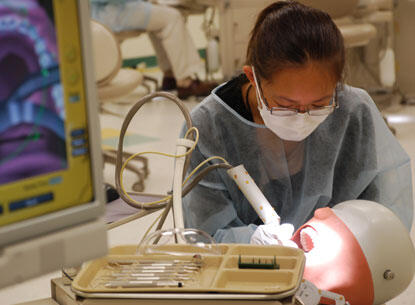
July 24, 2012
High School Students from Across Virginia Study Science and Medicine at VCU
Share this story
Twenty-six of Virginia’s brightest and most promising high school students interested in pursuing health care careers complete this week an intensive Governor’s School program hosted by VCU.
For four weeks, the students have eaten, slept and studied at VCU and the VCU Medical Center as part of the Summer Residential Governor’s School for Life Sciences and Medicine (GSLM).
“While the students are all unique and from diverse backgrounds, they share the common attributes of gifted intellect, academic excellence, self-direction, intrinsic motivation and a zeal for learning,” said Jeanne Minetree, GSLM director. “As a GSLSM faculty member is noted for saying, ‘These teenagers work harder for no grades than any student has worked for a grade during the regular school year.’”
“The program exposes us to different professions in health care to help us expand our perception of the health care field,” wrote one of the students, Hooman Azad, in an essay. “It is not just the doctors; there are scientists, counselors and many other people who are integral to the field but who are often ignored when we speak about health care.”
Minetree says one of the opportunities this program provides - when students work alongside medical and scientific professionals - is “the magnet that draws the best science students to apply … It’s the portal to real life medicine that high school students often cannot enter individually without the backing of a program such as GSLSM.”
One of the doctors involved, Imran Farooq, M.D., VCU Department of Internal Medicine chief medical resident, allowed the Governor’s School students in this year’s program to shadow his teams for several days.
“It is an inquisitive field with lots of interesting patients, lots of fun procedures, great teamwork in action as role modeled by our excellent residents and interdisciplinary teams - why not share this experience with future doctors and scientific scholars,” said Farooq.
Minetree stresses the uniqueness and importance of in-hospital shadowing.
“Without exposure to actual hospital clients, their health care providers and the diagnostic/treatment process, all learning would remain merely an academic exercise,” she said.
Students also shadowed doctors in the School of Dentistry.
Alan Booth, a GSLM student and Hampton High School rising junior, says he wants to become a dentist because he likes the idea of working with his hands in a world of computers, citing the “dexterity and spatial skills the job requires.”
The shadowing portion of GSLM is just one of four week-long phases. The remaining three weeks make up the program’s curriculum, which develops the connections among the triad of modern health care: the person (patient, family, and health care provider), the scientist (clinical laboratory scientists and researchers) and the community (epidemiologists and environmental scientists).
Andrea Nguyen, a rising senior at Hickory High School in Chesapeake, noted that the scientist portion of the program was particularly useful because it allowed her to see the way lab science is translated and applied to patients’ health.
Learning in the program is based on the case study method, which requires students to obtain medical histories, develop differential diagnoses, select diagnostic tests, interpret medical laboratory results and examination findings and create treatment plans.
“My impression before entering the program was that it would be classroom, traditional assignments and tests,” said Nguyen. “However, when I came it was case studies and hands-on work, which was more effective.”
Hans Carlo Rivera, another GSLM student, agrees. “Instead of just being an educational experience as I thought it would be on my first week, I have now found that it has the ability to impact our futures and what possibilities we have available after school,” he said.
Subscribe to VCU News
Subscribe to VCU News at newsletter.vcu.edu and receive a selection of stories, videos, photos, news clips and event listings in your inbox.










